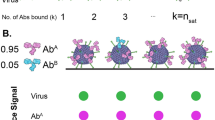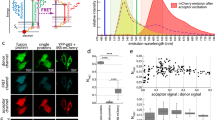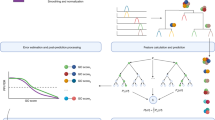Abstract
We present 'mix and measure' procedures for the analysis of protein complexes in microliters of crude human and mouse cell lysates using fluorescence correlation and crosscorrelation spectroscopy. We labeled interacting endogenous proteins by indirect immunofluorescence with all primary and secondary reagents added in one step. Especially for the screening of compounds interfering with interactions that depend on signaling-induced posttranslational modifications, the approach represents a major advance over existing protocols.
This is a preview of subscription content, access via your institution
Access options
Subscribe to this journal
Receive 12 print issues and online access
$259.00 per year
only $21.58 per issue
Buy this article
- Purchase on Springer Link
- Instant access to full article PDF
Prices may be subject to local taxes which are calculated during checkout


Similar content being viewed by others
References
Vamosi, G. et al. Proc. Natl. Acad. Sci. USA 101, 11082–11087 (2004).
Wange, R.L., Malek, S.N., Desiderio, S. & Samelson, L.E. J. Biol. Chem. 268, 19797–19801 (1993).
Werlen, G. & Palmer, E. Curr. Opin. Immunol. 14, 299–305 (2002).
Köhler, K. et al. ChemBioChem 6, 152–161 (2005).
Ottinger, E.A., Botfield, M.C. & Shoelson, S.E. J. Biol. Chem. 273, 729–735 (1998).
Paz, P.E. et al. Biochem. J. 356, 461–471 (2001).
Zhu, M., Janssen, E. & Zhang, W. J. Immunol. 170, 325–333 (2003).
Lin, J. & Weiss, A. J. Biol. Chem. 276, 29588–29595 (2001).
Sieh, M., Batzer, A., Schlessinger, J. & Weiss, A. Mol. Cell. Biol. 14, 4435–4442 (1994).
Sasahara, Y. et al. Mol. Cell 10, 1269–1281 (2002).
Rigler, R., Mets, Ü., Widengren, J. & Kask, P. Eur. Biophys. J. 22, 169–175 (1993).
Schaertl, S., Meyer-Almes, F.J., Lopez-Calle, E., Siemers, A. & Kramer, J. J. Biomolecul. Screen. 5, 227–237 (2000).
Acknowledgements
We thank G. Jung for excellent facilities in peptide chemistry and A. Nordheim for constant support. K.K. is a scholar of the Graduiertenkolleg 794. R.B. gratefully acknowledges financial support from the Volkswagen Foundation (“Nachwuchsgruppen an Universitäten”).
Author information
Authors and Affiliations
Corresponding author
Ethics declarations
Competing interests
I.C.D.J. is employed by Miltenyi Biotec GmbH, a company that produces some of the reagents used.
Supplementary information
Supplementary Fig. 1
Detection of the interaction of ZAP-70-YFP and CD3ε or ζ. (PDF 114 kb)
Supplementary Fig. 2
Mass tag-mediated detection of the interaction of endogenous ZAP-70 and CD3ε. (PDF 80 kb)
Rights and permissions
About this article
Cite this article
Stoevesandt, O., Köhler, K., Fischer, R. et al. One-step analysis of protein complexes in microliters of cell lysate. Nat Methods 2, 833–835 (2005). https://doi.org/10.1038/nmeth802
Received:
Accepted:
Published:
Issue Date:
DOI: https://doi.org/10.1038/nmeth802
This article is cited by
-
ProteomeBinders: planning a European resource of affinity reagents for analysis of the human proteome
Nature Methods (2007)
-
Structural systems biology: modelling protein interactions
Nature Reviews Molecular Cell Biology (2006)
-
One-step analysis of protein complexes in microliters of cell lysate using indirect immunolabeling & fluorescence cross-correlation spectroscopy
Nature Protocols (2006)
-
Fluorescence cross-correlation spectroscopy in living cells
Nature Methods (2006)



